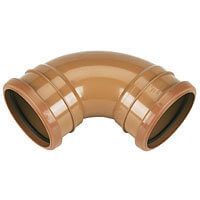Drainage Bend Double Socket - 87.5 Degree x 160mm
| Code | 6D561 |
|---|---|
| EAN Code | 5055149943447 |
| Angle | 87.5 Degree |
| Brand | PBSL Group |
| Colour | Terracotta |
| Material | PVC-u |
| Pack Size | Single |
| Style | Double Socket |
| Size | 160mm |
Our underground drainage bends are available with either a single or a double socket. The sockets are a simple push fit design with a captive rubber seal that is housed inside a moulded recess.
Drainage bends have a variety of used depending upon their angle. 88 degree bends are most commonly used vertically at the foot of a soil pipe or a rainwater pipe, whilst 45 degree bends are often used at the entry and exit points of an inspection chamber. 30 and 15 degree bends are generally used in the horizontal plane when a slight change of direction is required.
We always recommend the use of silicon lubricant with all push fit drainage fittings as it makes installation easier and maintains and enhances the performance of the seal in the long run.
160mm Underground Drainage
160mm underground drainage is most commonly used for a collection of flows from the 110mm pipes that flow into it. The range of fittings available in 160mm is generally smaller than the 110mm range, as a run of 160mm drainage is usually more direct and with fewer connections than 110mm pipe.
The fall required in a 160mm pipe depends on the peak flow in litres per second (as with 110mm pipes), but as a rule of thumb the fall it is shallower than that required for a 110mm pipe. The composition of backfill used can also be different, with slightly larger aggregate fill (pea shingle) being allowable for a 160mm pipe installation. Both of these criteria should be checked with local building control prior to installation.
In terms of installation and connecting pipes to fittings, the process is the same as with 110mm pipes. Cut pipes should always be chamfered prior to insertion into a fitting, and seals should be lubricated with silicon spray or grease.
160mm drainage is often still referred to as, reflecting the old comparative imperial size that was used. As this old pipe was commonly made from clay or salt glaze, flexible rubber adaptors are now available to make a straightforward connection from this old material to PVC.

